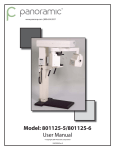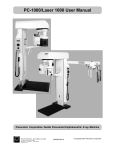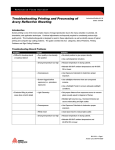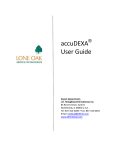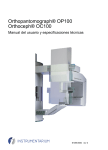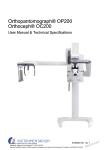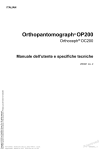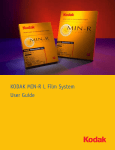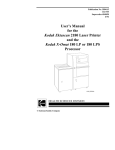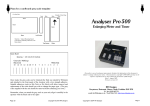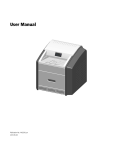Download UMF20000 Rev A - PC-3000 User Manual.indd
Transcript
User Manual Model: 8 0112 5 - 1 / 8 01125-2 UMF20000 Rev A www.pancorp.com | 800.654.2027 Table of Contents Introduction ______________________________________________________________________________3-5 Purpose ___________________________________________________________________________________________ 3 Statement of Compatibility ___________________________________________________________________________ 3 Safety Standards ____________________________________________________________________________________ 4 Warning of Voltage Regulators ________________________________________________________________________ 5 X-Ray Shielding Requirements ________________________________________________________________________ 5 Intended Use _______________________________________________________________________________________ 5 Warning Statements _________________________________________________________________________________ 5 Symbols & Definitions _______________________________________________________________________ 6 PC-3000 Components _______________________________________________________________________ 7 PC-3000 Control Panel _______________________________________________________________________ 8 PC-3000 Pre-Patient Setup _________________________________________________________________9-11 Prepare The Patient ________________________________________________________________________________ 10 Position The Patient ________________________________________________________________________________ 11 PC-3000 Patient Positioning _____________________________________________________________________ 11-12 Set The kVp _______________________________________________________________________________________ 11 Position The Patient ________________________________________________________________________________ 11 Recheck Patient Positioning _________________________________________________________________________ 12 Take The Exposure _________________________________________________________________________________ 12 Release The Patient ________________________________________________________________________________ 12 Process The Film ___________________________________________________________________________________ 12 PC-3000 TMJ Pre-Patient Setup __________________________________________________________________ 13-15 Prepare The Patient ________________________________________________________________________________ 14 Position The Patient ________________________________________________________________________________ 15 PC-3000 TMJ Patient Positioning_________________________________________________________________ 15-16 Set The kVp _______________________________________________________________________________________ 15 Position The Patient ________________________________________________________________________________ 15 Recheck Patient Positioning _________________________________________________________________________ 16 Take The Exposure _________________________________________________________________________________ 16 Release The Patient ________________________________________________________________________________ 16 Process The Film ___________________________________________________________________________________ 16 Panoramic Radiography ______________________________________________________________ Appendix A Darkroom Procedures________________________________________________________________ Appendix B Preventative Maintenance Guide ______________________________________________________ Appendix C PC-3000 Labeling ___________________________________________________________________ Appendix D PC-3000 Specifications _______________________________________________________________ Appendix E PC-3000 Space Requirements _________________________________________________________ Appendix F PC-3000 (MVT1000) _________________________________________________________________ Appendix G 2 Introduction Purpose Panoramic Corporation provides this printed manual as a guide for the operation of the PC-3000 dental panoramic X-ray machine. The PC-3000 will enable the user to take panoramic X-ray images. It is imperative that this equipment be installed, serviced, and used by personnel familiar with the precautions required to prevent excessive exposure to both primary and secondary radiation. This equipment features protective designs for limiting both the primary and secondary radiation produced by the X-ray beam. However, design features cannot prevent carelessness, negligence, or lack of knowledge. Only personnel authorized by Panoramic Corporation are qualified to install and service this equipment. Any attempt to install or service this equipment by anyone not so authorized will void the warranty. Statement of Compatibility - January 1, 1988 Please address any comments/questions concerning this statement of compatibility to: Panoramic Corporation • 4321 Goshen Road • Fort Wayne, IN 46818 USA The only components compatible with the PC-3000 are those supplied with the machine. Regardless of possible statements made by other manufacturers, no one is authorized or certified to make additions or deletions to this machine. Only the combination of components delivered with the machine is certified compatible by the manufacturer. As compatible accessories become available, Panoramic Corporation will certify them as compatible and make them available to the user. Statement of Compliance - December 17, 2004 The PC-3000 conforms to the following specifications: X-ray Generator type: Single phase, half-wave, self rectified, center-grounded in accordance with IEC 60601-2-7:1998 3 Introduction Safety (Class B Device; Shock, Fire, Casualty) • IEC 60601-1 Medical Electrical Equipment - Part 1: General Requirements for Safety • IEC 60601-1:1998 + A1:1991 + A2:1995 Medical electrical equipment - Part 1-1: General requirements for safety Collateral standard: Safety requirements for medical electrical systems • IEC 60601-2-7:1998 Medical electrical equipment - Part 2-7: Particular requirements for the safety of high-voltage generators of diagnostic X-ray generators • IEC 60601-2-28:1993 Medical electrical equipment - Part 2: Particular requirements for the safety of X-ray source assemblies and X-ray tube assemblies for medical diagnosis • IEC 60601-2-32:1994 Medical electrical equipment - Part 2: Particular requirements for the safety of associated equipment of X-ray equipment • EN 60601-1:1990 + A1:1993 + A2:1995 + A3:1996 Medical electrical equipment - Part 1-1: General requirements for safety - Collateral standard: Safety requirements for medical electrical systems • CAN/CSA C22.2 NO. 601-1-M90 + A1:1994 + A2:1998 Medical Electrical Equipment - Part 1: General Requirements for Safety X-Ray Evaluation • IEC 60601-1-3:1994 Medical electrical equipment - Part 1: General requirements for safety - 3. Collateral standard: General requirements for radiation protection in diagnostic X-ray equipment Software Review • IEC 60601-1-4:1996 + A1:1999 Medical electrical equipment - Part 1-4: General requirements for safety - Collateral Standard: Programmable electrical medical systems EMC (Class B Device): • EN 60601-1-2:2001 (IEC 60601-1-2:2001) Medical electrical equipment - Part 1-2: General requirements for safety Collateral standard: Electromagnetic compatibility - Requirements and tests • EN 55011:1998 + A1:1999 + A2:2002 Industrial, scientific and medical (ISM) radio-frequency equipment - Radio disturbance characteristics - Limits and methods of measurement • EN 61000-3-2:2000 Electromagnetic compatibility (EMC) - Part 3-2: Limits - Limits for harmonic current emissions (equipment input current <= 16 A per phase) • EN 61000-3-3:1995 + A1:2001 Electromagnetic compatibility (EMC) - Part 3-3: Limits - Limitation of voltage changes, voltage fluctuations and flicker in public low-voltage supply systems, for equipment with rated current <= 16 A per phase and not subject to conditional connection • EN 60601-1-2:2001 (IEC 60601-1-2:2001) Electromagnetic Compatibility - Requirements and Tests • EN 61000-4-2:1995 + A1:1998 + A2:2001 (IEC 1000-4-2) Electromagnetic compatibility (EMC)- Part 4-2: Testing and measurement techniques - Electrostatic discharge immunity test • EN 61000-4-3:2002 (IEC 1000-4-3) Electromagnetic compatibility (EMC) - Part 4-3: Testing and measurement techniques - Radiated, radio-frequency, electromagnetic field immunity test • EN 61000-4-4:1995 + A1:2001 + A2:2001 (IEC 1000-4-4) Electromagnetic compatibility (EMC) - Part 4-4: Testing and measurement techniques - Electrical fast transient/burst immunity test • EN 61000-4-5:1995 + A1:2001 (IEC 1000-4-5) Electromagnetic compatibility (EMC)- Part 4-5: Testing and measurement techniques - Surge immunity test • EN 61000-4-6:1996 + A1:2000 (IEC 1000-4-6) Electromagnetic compatibility (EMC) - Part 4-6: Testing and measurement techniques - Immunity to conducted disturbances, induced by radio-frequency fields • EN 61000-4-8:1993 + A1:2001 (IEC 1000-4-8) Electromagnetic compatibility (EMC) - Part 4-8: Testing and measurement techniques - Power frequency magnetic field immunity test • EN 61000-4-11:1994 + A1:2001 (IEC 1000-4-11) Electromagnetic compatibility (EMC) - Part 4-11: Testing and measurement techniques - Voltage dips, short interruptions and voltage variations immunity tests 4 Introduction Voltage Regulator Warning Do not plug this machine into ANY voltage regulating device. Contact Panoramic Corporation with any questions regarding this. X-ray Shielding Requirements The requirements for panoramic and cephalometric shielding for building, operator, and patient, depend on state and local regulations. Contact your state Department of Health for compliance information. Compliance could involve a blueprint review, facility check, wall construction, film badge implementation, remote switch installation, and/or a lead apron. It is beyond the scope of this manual to advise on these regulations. Intended Use An extraoral source X-ray system is an AC-powered device that produces X-rays and is intended for dental radiographic examination and diagnosis of diseases of the teeth, jaw and oral structures. Warning Statements Warning: This X-ray unit may be dangerous to patient and operator unless safe exposure and operating instructions are observed. During installation, machine is leveled to the floor. Do not move/transport the machine before contacting Panoramic Corporation Service Department at (800)654-2027. Notice: Ground reliability can only be acheived when this equipment is connected to a hospital only or hospital grade receptacle. The use of accessory equipment not complying with the equivalent safety requirements of this equipment may lead to a reduced level of safety of the resulting system. Consideration relating to the choice of accessory equipment shall include: • use of the accessory in the patient vicinity • evidence that the safety certification of the accesory has been performed in accordance to the appropriate IEC 60601-1 and/or IEC 60601-1-1 harmonized national standard. Portable and mobile RF Communications equipment can affect medical electrical equipment. Original document created in English. Panoramic Corporation requires anyone moving or transporting their machine to contact the Service Department at (800) 654-2027. 5 Symbols and Definitions SYMBOLS ~ Alternating Current Type B Equipment Attention, Consult Accompanying Documents I O On (power: connection to the mains) Off (power: disconnection from the mains) Dangerous Voltage Protective Earth (ground) Environmental Specifications Operating Temperature: Storage/Transportation Temperature: Operating Humidity: Storage/Transportation Humidity: Operating Altitude: Storage/Transportation Altitude: 10oC to 40oC (50oF to 105oF) -25oC to 70oC (-13oF to 158oF) 80% maximum relative humidity, noncondensing 80% maximum relative humidity, noncondensing 15,000 ft (4,500 m) maximum 15,000 ft (4,500 m) maximum Cleaning and Disinfection The following parts on the PC-3000 come into contact with the patient during normal operation: Black Chinrest Temple Supports Forehead Support Handles Use 70% Isopropyl Alcohol or Germicidal cloths (or equivalent) to clean and disinfect these parts. Do not attempt to clean any parts while machine is switched on. Mode of Operation Continuous operation with short time loading. Electrical Safety Class I, Type B Applied Parts Equipment is classified as ordinary equipment (enclosed equipment without protection against ingress of water). Equipment not suitable for use in the presence of FLAMMABLE ANESTHETIC MIXTURE WITH AIR or WITH OXYGEN or NITROUS OXIDE. 6 PC-3000 Components Top Cover Rotating Arm Temple Supports Forehead Support Tubehead Mirror Control Panel Film Drum/Cassette Chinrest Exposure Switch Handles Base 7 PC-3000 Control Panel Exposure Indicator Allows user to select function or increase value Allows user to select function or decrease value Allows you to scroll to the next screen Accepts flashing value Allows you to move back one screen, and after exposure allows user to reset the rotating arm. Turns machine on and off Moves machine up in the user mode and scrolls up the menus in service mode Moves machine down in user mode and scrolls down the menus in service mode 8 PC-3000 Pre-Patient Setup 1. In a lighttight darkroom, load a panoramic film in the cassette sleeve between the intensifying screens. 2. Press POWER on the front of the control panel. The screen will now display: PANORAMIC CORPORATION 3. Press MODE The screen will now display: SELECT OPERATION PAN L (Select from TMJ L, TMJ R, Pan L or Pan R) To scroll, press the Adjust buttons (+) , (-) to select the function you wish to use. 4. Press ENTER after the selection is made. 5. Press MODE to move to the next screen The screen will now display: ARM NOT POSITIONED or ARM POSITIONED 6. If not positioned, press ENTER. The rotating arm will now reset to the “home” position for the operation you have selected. 7. Press MODE to move to the next screen The screen will now display your selected operation: PAN L KVP: 80.0 (the number will be flashing) 8. Loosen the knob on the rear of the film drum. 9. Load a film cassette sleeve on the film drum. a. Place the loaded cassette sleeve on the film drum with the lower edge of the cassette sleeve resting on the lower lip of the film drum. b. Attach the vertical velcro at the end of the cassette sleeve to the mating velcro on the end of the film drum. Ensure the cassette sleeve is flat against the film drum. c. Attach the velcro tab of the cassette sleeve to the mating velcro on the center of the film drum. d. The display will indicate which side (patient’s) the film drum will reset and start. Align the pointer on the rear of the film drum to the appropriate mark. If the display is set for Panoramic L, align the pointer to L1. If the display is set for Panoramic R, align the pointer to R1. e. Tighten the film drum knob on the rear of the film drum. Note: The film drum will rotate with increased friction after the film drum knob is tightened. Manual rotation, while the knob is tight, should be avoided to prevent abnormal wear. 9 PC-3000 Pre-Patient Setup 10. Using the knob at the rear of the forehead support, adjust the forehead support toward the mirror to allow room for positioning the patient. 11. Slide the temple supports apart to allow room for positioning the patient’s head. 12. Using the UP/DOWN switch on the control panel, adjust the chinrest arm until it is slightly higher than the patient’s chin. This will ensure that the patient stands up as straight as possible. 13. If a stool is to be used, place the stool so that the seat is centered under the chinrest. This will help ensure that the patient’s neck is straight. Prepare The Patient 1. Ask the patient to remove any metal objects, such as glasses, earrings, removable dentures, hearing aids, hair pins, neck chains, bib chains, and collar zippers from their head and neck area. These objects can prevent X-rays from reaching the film, causing poor diagnostic-quality images. 2. If a lead apron is used, and a panoramic poncho is not available, place the lead apron on the patient’s back. Ensure that it does not cover the back of the neck. As the tubehead rotates around the patient, the X-rays pass through the head at a slight upward angle. This allows the X-ray beam to pass through the skull more efficiently by avoiding the denser area of the patient’s skull. 3. Guide the patient into the PC-3000. Use the UP/DOWN switch on the control panel to adjust the chinrest arm until it is slightly higher than the patient’s chin. This will ensure that the patient is standing up as straight as possible. Caution: It is the responsibility of the operator to ensure no obstructions exist during column movement due to surroundings and/or patient. Movement can be terminated by releasing the UP/DOWN buttons. 4. Have the patient hold onto the handles and move his/her feet under the chinrest. This will help ensure that the patient’s neck is straight. 5. Place the appropriate chinrest on the permanent, black chinrest on the chinrest arm: a. Small Child – Removable, black plastic chinrest. Maybe needed to allow the child’s forehead to reach the forehead support. b. Adolescent and Adult – No additional chinrest. Majority of patients require no additional chinrest. c. Edentulous – Removable, clear plastic chinrest. Aids in centering and consistently positioning the patient. 10 PC-3000 Pre-Patient Setup 6. If the patient is not edentulous, insert a disposable bite-guide in the permanent, black chinrest. Have the patient bite on the disposable bite-guide. Ensure that the bite-guide is centered between the central incisors. For edentulous patients, have the patient bite on a 1 1/2” cotton roll to keep the maxilla and mandible separated. Position The Patient 1. Place your hand at the base of the patient’s skull and apply pressure vertically to stretch the neck while slowly lowering the machine until the patient’s Frankfort Plane is horizontal (parallel to the red guidelines on the temple supports). The Frankfort Plane is the imaginary line from the middle of the ear opening to the bottom of the eye orbit. A level Frankfort Plane will ensure that the upper and lower anterior teeth are in one vertical plane and will help stretch the patient’s neck enough to allow X-rays to pass between the vertebrae. 2. Using the knob on the rear of the forehead support, adjust the forehead support until it touches the patient’s forehead. 3. Center the patient’s head using the red line on the forehead support. Turn the mirror to see the patient to verify centering. 4. Gently slide the temple supports against the patient’s head. These will help keep the patient centered and measure the width of the skull to determine the amount of kVp required to penetrate the skull. Set The kVp 1. Note which number the arrow points to on the kVp scale decal on the outside of the temple support rod. 2. Press the Adjust +/- buttons to adjust the kVp setting per the temple supports. Plus (+) will increase the reading, (-) will decrease the reading. KVP range is 70.0-90.0 adjustable by 2.5 increments. 3. Press ENTER once the correct kVp setting is selected to lock in the value. The screen will now display: ADJUSTING KVP 4. Press MODE to move to the next screen. Exposure LED light will illuminate to solid green and screen will now display: PAN L 80.0 KVP Press EXPOSURE. 11 PC-3000 Patient Positioning Re-check Patient Positioning 1. Ensure that the: a. patient’s chin is firmly seated on the chinrest b. patient’s feet positioned directly beneath support handles c. patient’s head is centered d. patient’s Frankfort Plane is horizontal e. patient’s neck is stretched f. patient’s forehead is resting on the forehead support g. temple supports are against the patient’s head h. control panel indicates proper kVp through temple support rod Take The Exposure 1. Instruct the patient to close his/her lips around the disposable bite-guide, swallow, place his/her tongue on the roof of his/her mouth, and remain still during the exposure. This will help equalize tissue densities and help prevent unwanted artifacts and blurring. 2. Depress exposure button, screen will display WARMUP IN PROGRESS and have a slow beep (5-6 seconds). Exposure will then start, LED light will now display on Control Panel indicating Radiation is present and the rotating arm will begin to rotate around the patient. When exposure is complete, release the exposure button. Caution: It is the responsibility of the operator to ensure no obstructions exist during arm rotation due to surroundings and/or patient. Movement can be terminated by releasing the Exposure button. Release The Patient 1. Slide the temple supports away from the patient’s head to release the patient. 2. Raise bite guide. 3. Instruct the patient to step out of the machine. 4. The screen will now display: PANORAMIC CORPORATION 5. Press the RESET button and the machine will return to the “home” position. 6. Dispose of bite guide. Process The Film 1. Loosen the film drum knob on the rear of the film drum and remove the cassette sleeve from the film drum. 2. Under lighttight darkroom conditions, process the film. 12 PC-3000 TMJ Pre-Patient Setup A TMJ series is simply four two-second panoramic images exposed on one film. The TMJ film will show the patient’s right closed, right open, left open, and left closed temporomandibular joints. 1. In a lighttight darkroom, load a panoramic film in the cassette sleeve between the intensifying screens. 2. Press POWER on the front of the control panel. The screen will now display: PANORAMIC CORPORATION 3. Press MODE. The screen will now display: SELECT OPERATION TMJ L (Select from TMJ L, TMJ R, Pan L or Pan R) To scroll, press the adjust buttons (+)/(-) to select the function you wish to use. 4. Press ENTER after the selection is made. 5. Press MODE to move to the next screen The screen will now display: ARM NOT POSITIONED or ARM POSITIONED 6. If not positioned, press ENTER. The rotating arm will now reset to the “home” position for the operation you have selected. 7. Press MODE to move to the next screen The screen will now display: TMJ R KVP: 80.0 (the number will be flashing) 8. Loosen the knob on the rear of the film drum. 9. Load a film cassette sleeve on the film drum: a. Place the loaded cassette sleeve on the film drum with the lower edge of the cassette sleeve resting on the lower lip of the film drum. b. Attach the vertical velcro at the end of the cassette sleeve to the mating velcro on the end of the film drum. Ensure the cassette sleeve is flat against the film drum. c. Attach the velcro tab of the cassette sleeve to the mating velcro on the center of the film drum. d. Align the pointer on the rear of the film drum to L1. e. Tighten the film drum knob on the rear of the film drum. Note: The film drum will rotate with increased friction after the film drum knob is tightened. Manual rotation, while the knob is tight, should be avoided to prevent abnormal wear. 13 PC-3000 TMJ Pre-Patient Setup 10. Using the knob at the rear of the forehead support, adjust the forehead support toward the mirror to allow room for positioning the patient. 11. Slide the temple supports apart to allow room for positioning the patient’s head. 12. If a stool is to be used, place the stool so that the seat is centered under the chinrest. This will help ensure that the patient’s neck is straight. Prepare The Patient 1. Ask the patient to remove any metal objects, such as glasses, earrings, removable dentures, hearing aids, hair pins, neck chains, bib chains, and collar zippers from their head and neck area. These objects can prevent X-rays from reaching the film, causing poor diagnostic-quality images. 2. If a lead apron is used, and a panoramic poncho is not available, place the lead apron on the patient’s back. Ensure that it does not cover the back of the neck. As the tubehead rotates around the patient, the X-rays pass through the head at a slight upward angle. This allows the X-ray beam to pass through the skull more efficiently by avoiding the denser area of the patient’s skull. 3. Guide the patient into the PC-3000. Use the UP/DOWN switch on the control panel to adjust the chinrest arm until it is slightly higher than the patient’s chin. This will ensure that the patient is standing up as straight as possible. 4. Have the patient hold on to the handles and move his/ her feet under the chinrest. This will help ensure that the patient’s neck is straight. 5. Place the appropriate chinrest on the permanent, black chinrest on the chinrest arm: a. Small Child – Removable, clear plastic chinrest. Aids in centering and consistently positioning the patient. b. Adult – Removable, clear plastic chinrest. Aids in centering and consistently positioning the patient. c. Edentulous – Removable, clear plastic chinrest. Aids in centering and consistently positioning the patient. 14 PC-3000 TMJ Patient Positioning Position The Patient 1. Place your hand at the base of the patient’s skull and apply pressure vertically to stretch the neck while slowly lowering the machine until the patient’s Frankfort Plane is horizontal (parallel to the red guidelines on the temple supports). The Frankfort Plane is the imaginary line from the middle of the ear opening to the bottom of the eye orbit. A level Frankfort Plane will ensure that the upper and lower interior teeth are in one vertical plane and will help stretch the patient’s neck enough to allow the X-rays to pass between the vertebrae. 2. Using the knob on the rear of the forehead support, adjust the forehead support until it touches the patient’s forehead. 3. Center the patient’s head using the red line on the forehead support. Turn the mirror to see the patient to verify centering. 4. Gently slide the temple supports against the patient’s head. These will help keep the patient centered and measure the width of the skull to determine the amount of kVp required to penetrate the skull. Set The kVp 1. Note which number the arrow points to on the kVp scale decal on the outside of the temple support rod. 2. Position Patient and get kVp reading from temple supports. Place Cassette sleeve on Film drum, aligning the black line with R1. Or L1, depending upon the side of the machine that the film drum is on. 3. Press the Adjust +/- buttons to adjust the kVp setting per the temple supports. Plus (+) will increase the reading, (-) will decrease the reading. KVP range is 70.0-90.0 adjustable by 2.5 increments. 4. Press ENTER once the correct kVp setting is selected to lock in the value. The screen will now display: ADJUSTING KVP 5. Press MODE to move to the next screen. The screen will now display: TMJ R (1) 80.0 KVP Press EXPOSURE 15 PC-3000 TMJ Patient Positioning Re-check Patient Positioning 1. Ensure that the: a. patient’s chin is firmly seated on the chinrest b. patient’s feet positioned directly beneath support handles c. patient’s head is centered d. patient’s Frankfort Plane is horizontal e. patient’s neck is stretched f. patient’s forehead is resting on the forehead support g. temple supports are against the patient’s head h. control panel indicates proper kVp through temple support rod Take The Exposure 1. Instruct the patient to close his/her lips, swallow, place his/ her tongue on the roof of his/her mouth, and remain still during the four exposures. This will help equalize tissue densities and help prevent unwanted artifacts and blurring. 2. Depress exposure button, screen will display WARM UP IN PROGRESS and have a slow beep (5-6 seconds). Exposure will then start, LED light will now display on Control Panel indicating Radiation present and the rotating arm will begin to rotate around the patient. When exposure is complete, release the exposure button, the rotating arm will automatically return to the “home” position. 3. Align the film drum to position R2. The screen will now display: TMJ R (2) 80.0 KVP Press EXPOSURE. 4. Depress exposure button, screen will display WARM UP IN PROGRESS and have a slow beep. Exposure will then start, LED light will now display on Control Panel indicating Radiation present and the rotating arm will begin to rotate around the patient. When exposure is complete, release the exposure button, the rotating arm will automatically return to the opposite side of the rotation for the other two exposures. The screen will now display: ARM POSITIONING 5. Align the film drum to position L1. The screen will now display: TMJ L (1) 80.0 KVP Press EXPOSURE 6. Depress exposure button, screen will display WARM UP IN PROGRESS and have a slow beep. Exposure will then start, LED light will now display on Control Panel indicating Radiation present and the rotating arm will begin to rotate around the patient. When exposure is complete, release the exposure button, the rotating arm will automatically return to the start position for the L side of exposure. 7. Align the film drum to position L2. The screen will now display: TMJ L (2) 80KVP Press EXPOSURE 8. Depress exposure button, screen will display WARM UP IN PROGRESS and have a slow beep. Exposure will then start, LED light will now display on Control Panel indicating Radiation present and the rotating arm will begin to rotate around the patient. When exposure is complete rotating arm will automatically return to the “home” position. The screen will now display: PANORAMIC CORPORATION Release The Patient 1. Slide the temple supports away from the patient’s head to release the patient. 2. Instruct the patient to step out of the machine. Process The Film 1. Loosen the film drum knob on the rear of the film drum and remove the cassette sleeve from the film drum. 2. Under lighttight darkroom conditions, process the film. 16 Appendix Panoramic Radiography Panoramic Radiography has been in use for over 30 years. In panoramic radiography, the X-ray source and film rotate around the patient’s head at the same speed. Simultaneously, the film rotates about its own axis. X-rays are emitted from the tubehead in a very narrow vertical band, pass through the patient’s head (where some are absorbed), and strike the film cassette sleeve. Intensifying screens are used inside the film cassette sleeve. The intensifying screens glow whenever X-rays strike them, the more X-rays striking the screen, the brighter the glow. Film, which is sensitive to light, is placed between the intensifying screens. The more light that is exposed to the film, the darker the film is. Since the patient is between the X-ray source and the film, the amount of X-rays that reach the film will vary depending on the density of the patient’s anatomy. Dense matter, such as bone, will absorb more of the X-rays than less dense matter, such as tissue. Less X-rays reach the film when striking the teeth, causing them to appear on the film as lighter areas. More X-rays reach the film when striking tissue, causing it to appear on the film as darker areas. X-rays Film Drum Tubehead Film Cassette Sleeve In order to pass as many X-rays through the patient’s head as possible, the tubehead is tilted at a slight upward angle to: 1. Move the dense portion of the skull out of the path of the X-rays 2. Cause the upper and lower anterior root tips to be aligned vertically 3. Stretch the vertebrae in the neck to allow the X-rays to pass more efficiently through the vertebrae to expose the anterior teeth As the tubehead and film rotate around the patient, the film is gradually exposed by a narrow vertical band. It is imperative that the film is aligned to start at the correct position and that nothing stops the film drum or tubehead from moving while the exposure is being taken. Appendix A Darkroom Procedures The darkroom must be lighttight. Extraoral (panoramic/cephalometric) film is more sensitive than intraoral (bite-wings) film to light, and processing time and temperature. Manual Processing • Lighttight darkroom • Dip tanks • Timer • Developer and fixer solutions • Film Hanger • Water supply and drain • Safelight (GBX-2 filter or equivalent, 15 W bulb or less and at least 4’ from film) • Thermometer 1. 2. 3. 4. 5. 6. Prepare developer and fixer solutions according to the solution’s directions. Verify developer temperature. Under safelight conditions, remove the exposed film from the cassette sleeve and attach it to a film hanger. Set the timer based on the developer temperature and the processing chart. Immerse the film quickly into the developer and agitate it vigorously for only 5 seconds to dislodge any air bubbles. When the timer sounds, remove the film from the developer and immediately rinse it with water for 30 seconds while agitating it. Do not allow the excess developer to drain back into the developer tank. 7. Immerse the film into the fixer and agitate it for 5 seconds every 30 seconds. Allow the excess fixer to drain back into the fixer tank. 8. Immerse the film in the water wash tank and rinse it thoroughly. 9. Dry the film at room temperature or in a drying cabinet. Automatic Processing A thermometer should be present to periodically verify the temperature. It is imperative that the processor’s maintenance schedule is followed thoroughly. Manual Processing Film Type T-MAT (for use with Lanex screens) Developer Temperature Time 68º F 20.0º C 72º F 22.0º C 76º F 24.5º C 80º F 26.5º C 8 min 7 min 5 min 4 min Automatic Processing Rinse Fixer Wash 30 sec 60º F 15.5º C to 85º F 29.5º C 2-4 min 60º F 15.5º C to 85º F 29.5º C 5 min 60º F 15.5º C to 85º F 29.5º C 82º F 28.0º C 5.5 min 83º F 28.5º C 4.5 min 85º F 29.5º C 4 min Note: Extraoral film requires more frequent solution replenishment than intraoral film. One ounce of chemicals are typically required for replenishment for every 75 intraoral, 3 panoramic, or 2 cephalometric films. Appendix B Darkroom Procedures Darkroom Light Leak Test Extraoral film is more sensitive to light than intraoral film. The purpose of the intensifying screens inside of the cassette sleeve is to convert the X-ray energy into light, thus exposing the film. While the light sensitivity of the film allows a very small amount of radiation to expose the film, it also can pose a problem if the darkroom is not completely lighttight. Small light leaks can cause fogging of the film while handling and processing the film in the darkroom. The following test should be performed in the darkroom under safelight conditions to ensure it is lighttight: 1. Remove one sheet of extraoral film from the box. 2. Lay it on the counter in the darkroom under normal darkroom conditions. 3. Place a couple of coins, a pair of scissors, or any other opaque object on top of the film. 4. Wait for two minutes. 5. Process the film as usual. The processed film should be clear. None of the objects should be visible on the film. If any of the objects can be seen on the processed film, there is a light leak or other light source in the darkroom. The light leak fogs the test film, everywhere except where the opaque objects are blocking the light. To find the light leak, turn all of the lights off in the darkroom and inspect the darkroom for cracks around the door and ceiling tiles. Indicator lights on equipment, such as stereos, and improper safelights can also cause fogging. Turn off all unnecessary equipment and the safelight and try this test again. Appendix B Darkroom Procedures It is recommended that the panoramic cassettes be loaded with film just prior to use. Do not leave a film loaded in the cassettes for an extended period of time. This will prevent background radiation from prematurely exposing the film. The film should be stored in a cool and dark place. Loading The Panoramic Cassette In a lighttight darkroom, open the flexible, panoramic cassette sleeve and slowly remove the intensifying screens. Open the screens on the counter and place a sheet of panoramic film on top of one of the screens. Close the screens and slowly slide them back into the cassette sleeve. Ensure that the hinged end of the screens is placed into the cassette sleeve first and the “TUBESIDE” decal is facing the same direction as the writing on the outside of the cassette sleeve. Ensure that all excess air is expelled from the cassette sleeve. Note: Remove and discard the protective sheet from between new intensifying screens before their first use. Appendix B Preventative Maintenance Guide Panoramic Corporation strongly recommends a preventive maintenance be performed on your equipment at least every two years. All service requests must be submitted through Panoramic Corporation’s Service Department by calling our toll-free number at (800) 654-2027. Panoramic has an extensive network of independent installation and service organizations throughout the U.S. and Canada to install and service our products. The Independent Representatives have been specifically trained by our organization in the service and installation of Panoramic products. We strongly recommend that you use one of our Independent Representatives to service Panoramic products. To the extent you use third parties other than Independent Representatives to service Panoramic products, we cannot accept responsibility or liability for any work performed by those third parties and any resulting damages or liability attributable thereto. In no event shall Panoramic be liable to you or any other third party for any direct, indirect, punitive, incidental, consequential or special damages or lost profits arising from, relating to or connected with, the installation of or repair of a Panoramic product by someone other than an Independent Representative. Always refer to your state and local regulations to determine how often to perform a preventive maintenance on your equipment as the regulations may supersede manufacturers’ recommendation. Owners of Panoramic Corporation X-Ray machines must call Panoramic Corporation Service Department for all reasons listed below but not limited to: - Preventive maintenance at least every two years Physical relocation of machine Changing the power source to a different power source from original installation Questions/Help related to compliance with your state, and local regulations regarding radiological equipment Corrective Maintenance Physical damage that may affect radiation safety Interrupted movement, unusual noises, leaks, etc. To schedule a preventive maintenance on your equipment contact the Service Department by dialing our toll-free number at (800) 654-2027. Appendix C PC-3000 Labeling Control Panel Appendix D Appendix E PC-3000 Specifications PC-3000 Specifications Power Requirements Model 801125-1: 105-125 VAC, 50/60 Hz, 10A Model 801125-2: 100/230/240 VAC, 50/60 Hz, 10A Generator Type Single-phase, half-wave, self-rectified, center-grounded. Duty Cycle At 90 kVp/6 mA - One 12 second exposure every 5 minutes to a maximum of 30 exposures. Tubehead Assembly X-ray Tube Brand X-Ray or K-Alpha Rated Tube Potential Peak 100 kVp Leakage Technique Factors 90 kVp/6 mA Inherent Filtration 1 mm Added Aluminum Filtration 1.8 mm Total Filtration 2.8 mm Manufacturer Type Focal Spot Maximum Peak Voltage Anode Heat Dissipation Rate Anode Heat Storage Capacity Brand X-Ray or K-Alpha Peak Tube Potential Tube Current Exposure Time ± 12% over range of rated line voltage Exposure Time Measured with Engineered Systems & Design Model XR201MS pulse counter. Tube Current Measured directly with a DC mA meter having a basic accuracy of no less than ± 3%. Peak Tube Potential Measured using a computerized kVp measurement system NeroMax Victorean. System accuracy is ± 3% exclusive of waveform, inherent filtration, and reproducibility. Maximum Line Current Machine set at 90 kVp/6 mA X-ray Tube Statement of Deviation Measurement Techniques Screen/Film Type BX-4P0.5 or KAX-90-10-P .5 mm x .5 mm 100 kVp 250 Watts 1 Watt=1.4 H.U./sec. 35 kJ 1 kJ=1400 H.U. ± 10% over line voltage ± 10% over line voltage Kodak Ektavision with Kodak Ektavision G Appendix E PC-3000 Space Requirements 35" 23" Physical Dimensions 35" W x 42" D x 91" H Minimum Working Space 48" W x 48" D x 91" H 42" 32" The PC-3000 weighs approximately 415 pounds and is freestanding, requiring no extra support in the wall or floor. 91" Maximum 58" Minimum The factory configuration is shipped with the control panel mounted on the patient's left side, unless specified by the customer prior to shipping. The control panel can be easily relocated to the right side at the time of installation. Note: The FDA requires that the technique factors (kVp meter) be viewable during the exposure. Appendix F MVT 1000 Diagram Model 801125-2 includes MVT1000 attached to the rear of the machine. MVT1000 power cords must be connected as shown. MVT1000 MVT1000 power cord to machine MVT1000 power cord to power source Appendix G




























